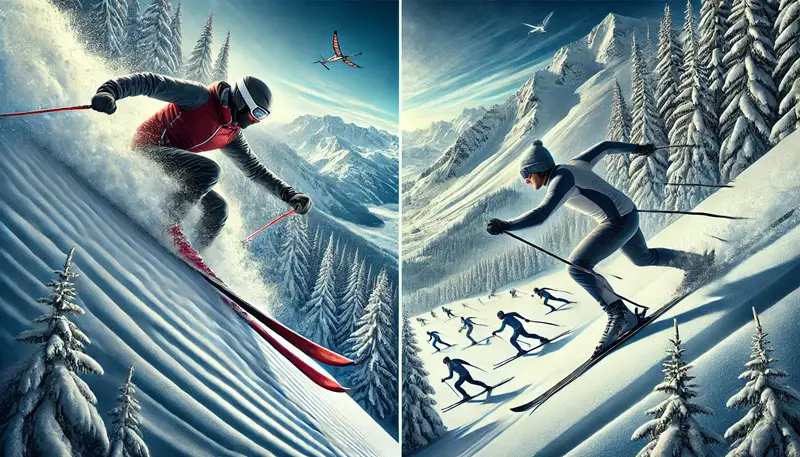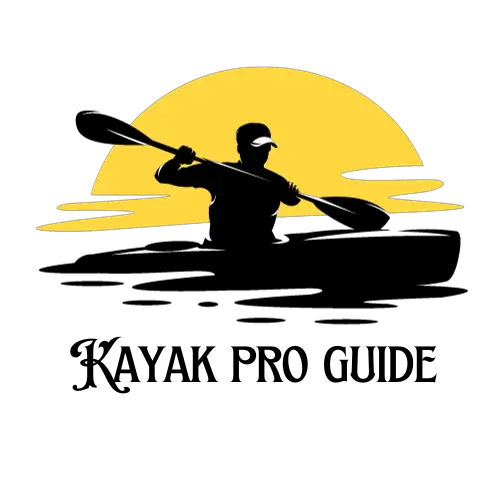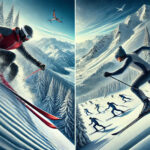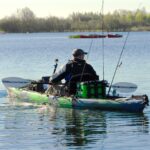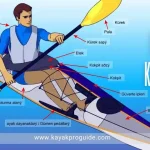Have you ever wondered what alpine skiing offers, excluding Nordic Skiing? If you are these two popular winter sports, what is the difference between Alpine and Nordic Skiing? What Is The Difference Between Alpine And Nordic Skiing?
Interested in the difference between whom. Then you don’t need to find anything else. I will provide you with all the information. Actually, both have to hit the snowy terrain.
Basically, the difference between the techniques between them to all setups also exists. You are a skilled skier or experienced in snow.
Understanding the difference between Alpine and Nordic Skiers will make your skills move forward one step further.
So, let’s join me and uncover the mystery. These two snowy adventures are what make it unique.
What Is Alpine And Nordic Skiing?
Alpine Skiing is a winter sport. Where the participants ski down the snowy mountain slopes.
Skiers use long, narrow skis with fixed heel bindings to navigate downhill slopes marked with gates.
This exciting game combines speed and accuracy. As skiers navigate challenging slopes with slalom and giant slalom courses.
Alpine Skiing is a popular competitive sport in the Winter Olympics. A recreational activity enjoyed by ski lovers worldwide. Where both skill and agility are demonstrated on the ice slopes.
Nordic Skiing is a winter sport. Which involves cross-country skiing in different regions. Participants use lightweight skis and poles using a free heel binding system.
This endurance-based activity includes techniques such as classic and skate Skiing.
Nordic and Alpine skiing are both recreational and competitive sports.
Often takes place in beautiful scenery. It provides a full-body workout. Appreciated for its connection with nature and winter exploration.
What Is The Difference Between Alpine And Nordic Skiing?
Alpine and Nordic Skiing are both popular winter sports. Both games enjoy natural beauty. A full-body workout as well.
However, there are several fundamental differences between them. Let’s take a look at them:
Ski Type
- Alpine skis use long (185-205 cm) and wide (5.5-8.5 cm) skis. They are designed for rapid descent.
- Nordic’s long (185-215 cm) and narrow (3.5-5.5 cm) skis are used. They are comfortable for long distances.
Boots
- Stiff and heavy boots, which emphasize control and speed rather than movement, are typical of alpine skis.
- Soft and light boots, which facilitate movement like walking Nordic skis.
Binding
- Alpine sticks perfectly to the skis with the feet. As a result, control becomes easier. But, it cannot be pushed with feet.
- The Nordic foot sticks gently to the ski. As a result, kicking becomes easier, and distances can be covered.
Style
Alpine allows for rapid descents, jumps, spins, and maneuvers on high slopes. Walking at a slow pace on flat terrain or up and down slopes, covering distances, and exercising is Nordic.
Other Differences
- Equipment: Special poles are not used in Alpine. In the Nordics, two-handed poles are used.
- Competition: There are speed events like alpine slalom, giant slalom, downhill, etc. Nordic has events such as cross-country, ski jumping, and Nordic combined.
- Choice: Those who love excitement and speed choose Alpine. Nordic is good if you want to exercise, enjoy nature, and cover long distances.
Which One Is For You?
Choose based on your preference, physical ability, and experience. Good for those who love alpine excitement and speed. Nordic, on the other hand, is good for preferring peace and distance.
Nordic can be easy in the beginning. Later, you can take up the alpine challenge. Choose the one of your choice and enjoy the snowy experience.
What Distinguishes Alpine Skiing From Nordic Skiing?
Alpine Skiing and Nordic Skiing may seem similar sports to many. But, they have distinct differences that make each experience unique.
One of the main differences is in the tools used. Alpine Skiing involves using long, fixed-heel skis and boots. Which latches onto the bindings, allowing efficient hill descents.
On the other hand, Nordic Skiing uses light, free-heel skis and boots. Which is not attached to the skis on the hill, providing more mobility for cross-country terrain.
What Equipment Is Unique to Each Type of Skiing?
The most unique piece of equipment when it comes to alpine Skiing is a pair of traditional downhill skis. They have slightly curved shapes and high-quality construction.
Which allows for faster speeds and better control over the grooming options. Additionally, alpine Skiing also requires a set of sturdy ski boots that provide ankle support.
For cross-country skiing, the standout piece of equipment is long and narrow skis with fish-scale or waxless bases.
These skis are designed to provide better glide on flat terrain while providing traction while climbing.
Cross-country ski poles are longer than those used in other types of Skiing. Because they provide stability and rhythm to both classic and skate-style techniques.
Basically, all of the above are: What Is The Difference Between Alpine And Nordic Skiing?
What Are The Main Physical Fitness Requirements For Each type of Skiing?
Skiing is a very popular sport in most European countries, including America and Canada. Skiing requires a variety of physical abilities. But, in general, all types of Skiing require some basic physical abilities.
Physical Strength
While Skiing, you need to control the ski or board. Balance must be maintained. Moreover, there are some problems to deal with while going down the slope. So, strong leg muscles, waist, and shoulders are needed.
Cardiovascular Fitness
Going down the slope will require physical exertion for a long time. That requires good cardio fitness. Regular exercise like walking, running, or cycling prepares the body.
High-quality vision is required. Eye-body coordination is very important for good vision and quick reaction. Flexibility and balance should always be emphasized to maintain balance.
Remember, this is a general idea. The ability required for different types of Skiing (water, snow, grass) may differ slightly. In particular, snow skiing also requires the ability to tolerate cold weather.
How To Train For Alpine And Nordic Skiing?
Training for Alpine and Nordic Skiing adds to the winter fun by challenging both the body and the mind. Here are some important tips:
Physical Fitness
- Cardio: Long-term cardio exercises like running, cycling, swimming, rowing, etc., will increase endurance.
- Strength training: Do squats, lunges, deadlifts, etc., to strengthen leg, waist, and core muscles.
- Balance and coordination: Using a balance board, standing on one leg, jogging, etc., will improve balance and coordination.
Technical Skills
- Dryland Training: Understand the basics by doing exercises that simulate skiing movements (roller skis) or by watching video tutorials.
- Basic lessons: Learn basic techniques at a ski school or with an experienced skier.
- Practice: Practice on easy slopes according to your level. Then, gradually take on harder challenges.
Frequently Asked Questions
Do I need different tools for Alpine and Nordic Skiing?
You will need different skis, boots, and bindings for each type of Skiing.
What kind of Skiing is more suitable for newcomers?
Alpine Skiing is usually easy for newcomers due to its focus on downhill regions and steady-heel bindings.
Can I switch between Alpine and Nordic Skiing in one day?
If you have the appropriate equipment, you can easily switch between both types of Skiing in one day.
Does Alpine and Nordic Skiing have specific trails or territories nominated for?
Many ski resorts have separate zones or trails, especially for alpine and Nordic Skiing.
Does Skiing, a type of Skiing, physically claim more than the other?
Nordic Skiing is more physical because of the nature of free heel binding and cross-country territory.
Final Thoughts About What Is The Difference Between Alpine And Nordic Skiing?
Both alpine and Nordic Skiing involve gliding over snow. Although similar in appearance to snow, there are several key differences between the two. Alpine Skiing is usually done on steep slopes.
Fixed heel bindings and long skis are used for speed and control. On the other hand, Nordic Skiing is on flat ground. It can also include various techniques, such as cross-country skiing and ski jumping.
Nordic skiers use free-heel bindings and smaller skis to facilitate maneuvers. So, when you hit the slopes. Choosing your style strategy must be intelligent.
